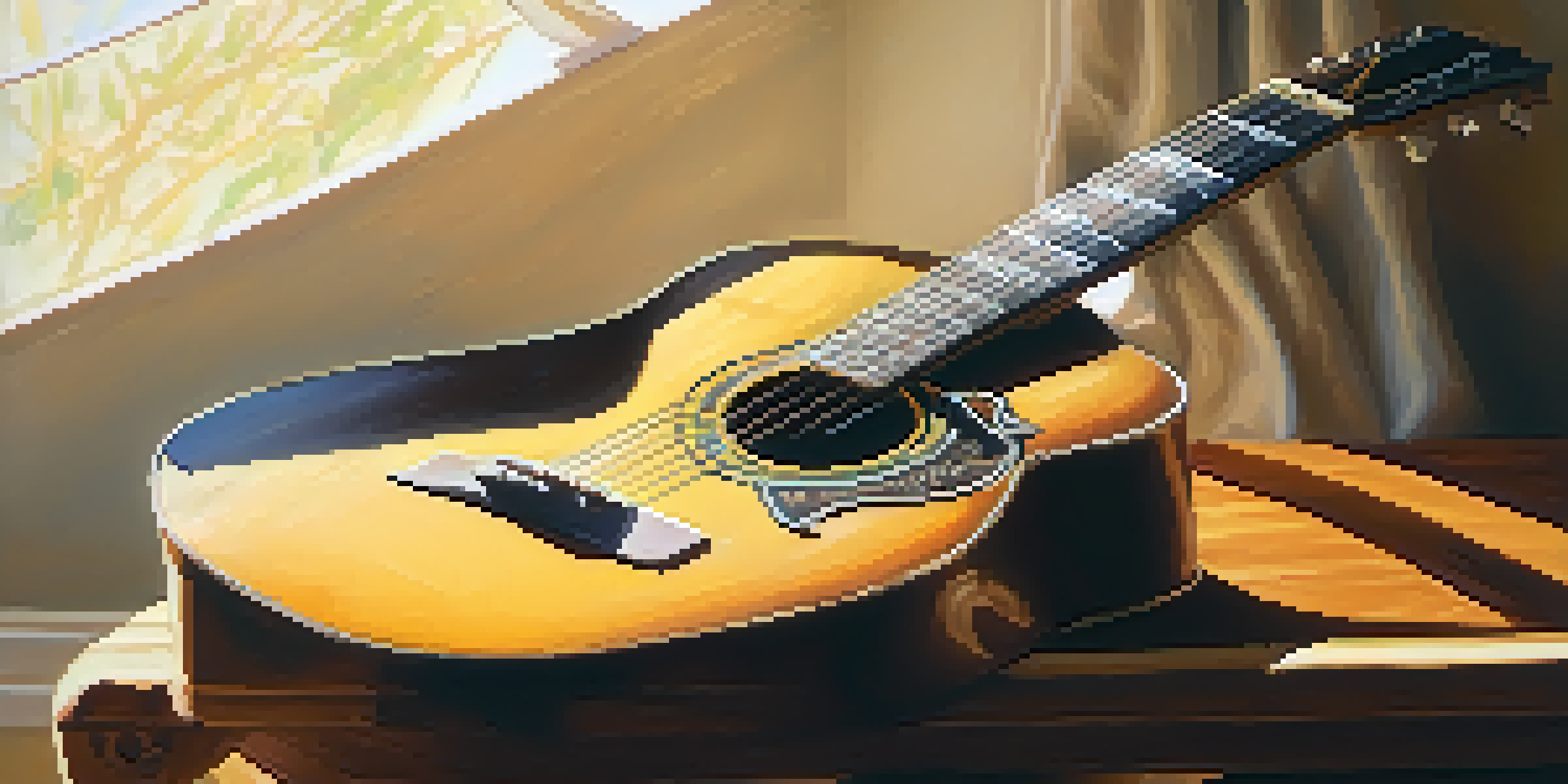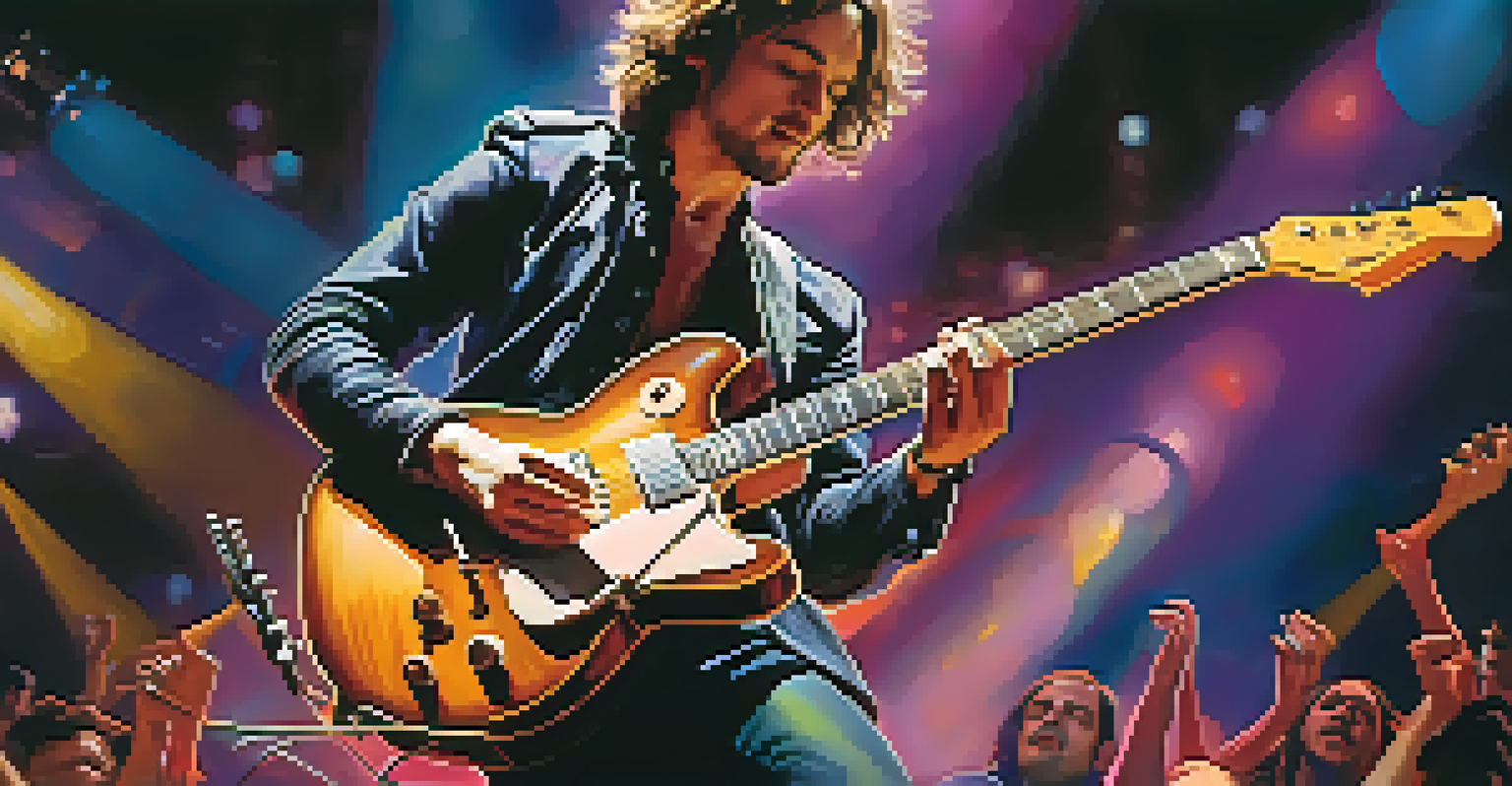The Role of Guitar in Movie Soundtracks and Scores

The Emotional Power of Guitar in Film Music
The guitar, with its versatile sound, has a remarkable ability to evoke emotions. From the soft strumming of an acoustic guitar to the electrifying riffs of a rock solo, it can instantly set the mood of a scene. Think of how the gentle notes can create an atmosphere of nostalgia or longing, perfectly complementing a heartfelt moment in a movie.
Music can change the world because it can change people.
For instance, in films like 'The Motorcycle Diaries', the acoustic guitar enhances the emotional journey of the characters. Its warm tones wrap around the viewer, drawing them deeper into the narrative. This emotional connection is what makes the guitar an invaluable tool for filmmakers seeking to resonate with their audience.
Ultimately, the guitar serves not just as a musical instrument, but as a conduit for storytelling. Its ability to convey complex feelings helps to anchor the viewer's experience, making each scene memorable and impactful.
Iconic Movie Themes Featuring Guitar
Many classic films have memorable themes that prominently feature guitar, making them instantly recognizable. Take 'The Good, The Bad and The Ugly', where the haunting guitar riffs establish a tense atmosphere that defines the film. This iconic theme has transcended generations, showcasing the guitar's power to create lasting impressions.

Another great example is 'Inception', where the use of the guitar adds layers of tension and complexity to the score. Hans Zimmer cleverly integrates this instrument, bringing a unique texture that enhances the film's dreamlike quality. Such themes often linger long after the credits roll, proving the guitar's effectiveness in film scores.
Guitar Evokes Strong Emotions
The guitar's versatile sound can evoke a range of emotions, enhancing the viewer's connection to a film's narrative.
These iconic themes illustrate how the guitar can become synonymous with a film, often overshadowing the visual elements. It’s a testament to its versatility and the emotional depth it adds to cinematic storytelling.
Guitar Genres and Their Film Applications
Different genres of guitar music bring unique flavors to film soundtracks. For instance, classical guitar often finds its place in romantic or dramatic scenes, providing an elegant backdrop. In contrast, rock guitar can energize action sequences, ramping up the adrenaline and excitement for the audience.
The guitar is a remarkable instrument. It can express things that words can't.
Consider how the gritty sound of electric guitar defines many thriller and horror films. It creates an unsettling atmosphere, drawing viewers into the tension of the plot. Movies like 'The Shining' use dissonant guitar sounds to enhance the suspense, illustrating how genre influences the choice of guitar style.
By understanding how different guitar genres fit into various film contexts, filmmakers can better harness its power. This strategic approach ensures that the soundtrack aligns seamlessly with the narrative, heightening the overall impact of the film.
The Role of Guitar in Character Development
Guitar music often reflects the personality and journey of characters in films. For example, a solitary character might be accompanied by soft acoustic guitar, portraying their introspective nature. This connection between music and character can deepen the audience's understanding of their emotional struggles.
In 'A Star is Born', the guitar becomes a symbol of the protagonist's aspirations and vulnerabilities. As the characters evolve, so does the music, illustrating their growth and challenges. This dynamic relationship showcases how guitar can act as a narrative device, enriching character arcs.
Cultural Significance in Film
Guitar music often reflects cultural themes, enriching narratives and grounding them in their geographical contexts.
Thus, the guitar not only adds atmosphere but also serves as a voice for the characters themselves. It helps to convey their inner thoughts and emotions, making the story more relatable and engaging for viewers.
The Cultural Significance of Guitar in Film
Guitar music often reflects cultural themes and influences, adding layers of meaning to films. For instance, in films set in Latin America, the use of flamenco guitar can evoke a sense of place and authenticity. This cultural specificity enriches the narrative, grounding it in its geographical context.
In movies like 'Coco', the guitar not only serves as a musical instrument but also as a symbol of family and heritage. The melodies resonate with the cultural roots of the characters, enhancing the emotional depth of the story. Such cultural representations through guitar help audiences connect with diverse narratives.
By integrating culturally significant guitar styles, filmmakers can create a more immersive experience. This approach highlights the role of music as a bridge between the characters' experiences and the audience's understanding.
Guitar as a Tool for World-Building in Films
The guitar plays a crucial role in world-building within films, helping to establish the setting and time period. For example, a period drama might feature a lute or classical guitar, transporting viewers to a different era. These choices in instrumentation help create an authentic atmosphere that enhances the storytelling.
In modern sci-fi films, electric guitar can be used to create futuristic soundscapes, adding to the overall visual and auditory experience. Think of films like 'Blade Runner', where the guitar blends with electronic elements to create a unique world. This fusion adds depth to the film's universe, making it more captivating.
Collaboration Enhances Soundtracks
The partnership between composers and guitarists can lead to innovative soundtracks that elevate a film's identity.
Through thoughtful integration of guitar, filmmakers can craft a rich auditory landscape that complements the visual narrative. This synergy between sound and image is key to immersing viewers in the film's world.
Collaborations Between Composers and Guitarists
The collaboration between film composers and guitarists can lead to innovative and memorable soundtracks. Many famous film scores emerge from this partnership, combining the composer's vision with the guitarist's unique style. This synergy can result in a soundtrack that feels both fresh and cohesive.
For example, composer Ennio Morricone famously worked with guitarists to create the unforgettable themes for spaghetti westerns. The distinct sound of the guitar became a hallmark of the genre, showcasing how collaboration can shape a film's identity. Such partnerships often yield innovative compositions that resonate with audiences.

Ultimately, these collaborations highlight the importance of teamwork in filmmaking. By blending different talents, filmmakers can create a richer auditory experience that enhances the film's emotional and narrative depth.